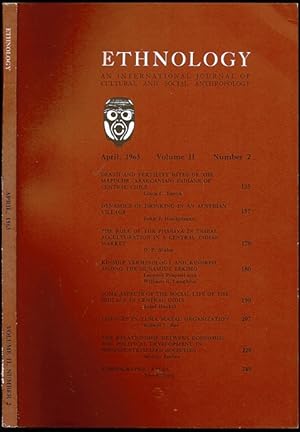louis faron leopold pospisil william (1 risultati)
Tipo di articolo
- Tutti gli articoli
- Libri
- Riviste e Giornali (1)
- Fumetti
- Spartiti
- Arte, Stampe e Poster
- Fotografie
- Mappe
-
Manoscritti e
Collezionismo cartaceo
Condizioni
- Tutte
- Nuovi
- Antichi o usati
Legatura
- Tutte
- Rilegato
- Brossura
Ulteriori caratteristiche
- Prima edizione
- Copia autografata
- Sovraccoperta
- Con foto
- No print on demand
Paese del venditore
Valutazione venditore
-
Death and Fertility Rites of the Mapuche (Araucanian) Indians of Central Chile with Kinship Terminology and Kindred Among the Nunamiut Eskimo in Ethnology Volume II, Number 2
Editore: University of Pittsburgh Press, Pittsburgh, 1963
Da: The Book Collector, Inc. ABAA, ILAB, Fort Worth, TX, U.S.A.
Rivista / Giornale Prima edizione
Soft cover. Condizione: Very Good. 1st Edition. Death and Fertility Rites of the Mapuche (Araucanian) Indians of Central Chile 135-156 pages with bibliography; Kinship Terminology and Kindred Among the Nunamiut Eskimo 180-189 pages with bibliography. Royal octavo (9 1/2" x 6 1/4") bound in original publisher's wrappers. Ethnology Volume III, Number 2. First edition. Death and Fertility Rites of the Mapuche (Araucanian) Indians of Central Chile. An estimated 200,000 Mapuche Indians live on approximately 2,200 small reservations, in an area of about one-half million hectares, distributed over several political provinces in southern central Chile. In spite of military conquest, pacification, settlement on reservations, marginal incorporation into a regional agricultural economy--all important accommodations to colonial status--they have maintained a cultural and social distinctiveness vis-a-vis Chilean culture and society. Condition: Light edge wear, corners bumped else very good. Kinship Terminology and Kindred Among the Nunamiut Eskimo in Ethnology. The Nunamiut Eskimo are nomadic caribou hunters of the interior of northern Alaska. At the time of their first contact with Western society they number approximately 1,500 people, who exploited extensive hunting grounds between the timber line in the Brooks Range and the northern coast of Alaska. Their territory extended roughly from 147 degrees to 160 degrees west longitude and from 68 degrees to 70 degrees north latitude. At the turn of the century the heard of caribou declined in numbers to such an extent that most of the Nunamiut were forced to leave the interior and move to the coast. Later some of these people, numbering 85 individuals in the year 1957, still survives at Anaktuvuk Pass in the central area of the Brooks Range. Condition: Corners bumped, some indentation to the cover else very good.


